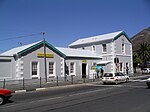The Cape Peninsula (Afrikaans: Kaapse Skiereiland) is a generally mountainous peninsula that juts out into the Atlantic Ocean at the south-western extremity of the African continent. At the southern end of the peninsula are Cape Point and the Cape of Good Hope. On the northern end is Table Mountain, overlooking Table Bay and the city bowl of Cape Town, South Africa. The peninsula is 52 km long from Mouille point in the north to Cape Point in the south. The Peninsula has been an island on and off for the past 5 million years, as sea levels fell and rose with the ice age and interglacial global warming cycles of, particularly, the Pleistocene. The last time that the Peninsula was an island was about 1.5 million years ago. Soon afterwards it was joined to the mainland by the emergence from the sea of the sandy area now known as the Cape Flats. The towns and villages of the Cape Peninsula and Cape Flats, and the undeveloped land of the rest of the peninsula now form part of the City of Cape Town metropolitan municipality. The Cape Peninsula is bounded to the north by Table Bay, to the west by the open Atlantic Ocean, and to the east by False Bay in the south and the Cape Flats in the north.
The peninsula is mostly the mountainous remnant of very old durable sandstone formations with low dip, deposited unconformably on an ancient underlying granite peneplain. The climate is of the Mediterranean type, with predominantly winter rainfall and mild temperatures, and the natural vegetation is exceptionally diverse, with an unusually large number of endemic plant species for an area of this size, many of which are endangered, and threatened by human activity and encroachment, but are to some extent protected on the large part of the peninsula which is in the Table Mountain National Park. The coastal waters include a major seaport in Table Bay, and a marine protected area in the two adjacent but significantly different marine ecoregions, which meet at Cape Point. Most of the lower lying coastal land of the central and northern peninsula has been developed as first agricultural, and later urban areas. The rocky uplands have historically avoided development because of difficult access, poor soils and steep slopes, and more recently have been legally protected as being of high ecological importance, but are threatened by illegal land invasion and informal settlement.










